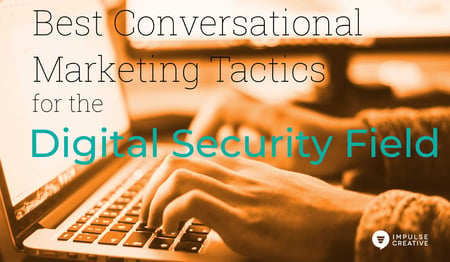Your digital security company is ready for growth. You’re working on content. You’re on social channels. You’re even working on a video strategy.
But are you having conversations?

When it comes to implementing this new and powerful marketing strategy into your online security brand, you’ll want to think about the user experience. It’s not just deploying a bot. It’s taking care of the different people visiting your channels.
Why?
Because people - which power your business - are inherently conversational. We want to interact. We crave engagement. And we don’t want to just “be sold to.”
This is why the first question conversion is critical when implementing a conversational marketing strategy. If your first question stinks, you won’t see the success you could see.
A winning first question will show you how well your message resonates with your audience.
Also, as a digital security brand, you’re probably serving a mix of returning, happy customers and people who have never interacted with your brand. When each persona visits your website and sees a chatbot available, they’ll want a seamless, instant experience.
What kind of chat strategy do you deploy to figure out how to help your existing customers and new contacts without confusing or offending either side?
You need a way to delegate chatbot and live chat messages between the support, service, and sales teams. It can get complicated. But there’s no need to fear what you don’t know.
We’re going to start with homepage conversational marketing tactics, just like your website visitors would most likely start with your homepage.
So when we think about conversational marketing and chat strategies, we think about it in a bottom-up structure. For instance, when it comes to returning customers, they have a certain expectation when coming back to your website. It’s important to think of the first question your chat tool asks them.
This is where we start. Who’s most likely coming to your website?
- Known customers (they’re cookied or signed in)
- New customers
- Unknown visitors and ABM visitors (groups, events, etc.)
Once we’re on the same page with thinking about who’s coming to the website, we can then tackle conversational marketing strategy for digital security businesses at a more granular level. We want to make sure your first-question conversion is stellar, for whoever is coming to your site.
3 Conversational Marketing Strategies for Digital Security Brand Website Visitors
1) Returning Visitors as Known Contacts/Customers
This is critical. Those customers who have done business with you in the past want to be known and feel known. Customer service at the next level.
We suggest starting with a chat tool that identifies your current customer base. Customers will feel left out immediately if they have nowhere to go for answers but new users have all the tools. In other words, if your returning customers have an immediate need, they expect an immediate response. It won’t bode well if your immediate answers focus solely on potential sales. Serve your current customers well, and they’ll stick around and may even sing your praises the world over!
So start with creating a knowledge base document that answers common questions, and can escalate a conversation to your support team.
HubSpot Service Hub & Drift can handle a knowledge base option with their tools.
When you show someone is a customer, you can choose to show them only support questions and upgrade opportunities. You should speak to them as a customer, not as a potential customer.
2) Known Contacts in Your Funnel - First-Time-Customers
Then it’s time to shift your focus to conversations with new visitors, potential customers, and leads. Now that you’re serving customers, it’s time to find new ones!
This is where a homepage conversational strategy shines. After your level one support, second tier are the people in your buyer’s journey, or your funnel. These are known contacts who aren’t yet customers. They’re the leads, the MQLs, the opportunities… you want to make sure you’re serving them up conversion opportunities.
This could look like continuing a conversation rather than starting that conversation (like you’d do with unknown contacts, covered below). You could even help connect these viewers to their sales rep,security advisor, or account manager if they have one, truly taking the personal touch to a deeper level.
What does this look like in real life? A chatbot that pops up with the sales rep, saying to the viewer, “I noticed you were interested in our server security tools. Other clients who explore this track often ask about firewalls and VPNs. What questions can I answer for you?”
Directing your known contacts who aren’t yet customers to the resources needed to help them make a decision will help them to feel better-served, building trust and positive connections in their minds. Creating conversation plans for each of the most common needs, then iterating on other questions that come in, and routing them to the best solutions for what they need.
3) Anonymous / Account Based Marketing (ABM)
The final tactic for conversational marketing at your digital security brand is to reach those anonymous viewers who are just starting off. I put these folks in the same bucket as account based marketing (ABM) leads, because we may not know who they are, but we know where they work based on data. So we can serve them up what we need to, in order to help convert them into known leads.
For instance, if you know you’re going after IT directors in Nebraska, and your data shows that’s who’s on your page, your chatbot can have a very specific message on resources for IT directors in Nebraska. And if they’re truly anonymous and your system can’t identify them, you get to have a more general, high-level conversation.
This is where the conversation begins; the beginning of a relationship. It’s important to serve up the right context to the right website viewers.
What’s Next
We offer a conversational snapshot to help you understand how your digital security company’s marketing is currently working. Let us help you find your way in this new world of conversational marketing.
Or you can always just ask. We're here to help!
Conversation photo by Alexis Brown on Unsplash
Digital photo by Glenn Carstens-Peters on Unsplash





